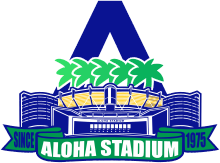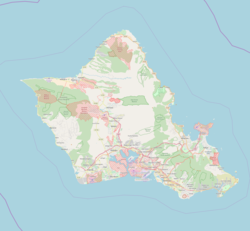 | |
 The stadium in 2024 | |
Location on the island of Oahu | |
| Address | 99–500 Salt Lake Boulevard Aiea, HI 96701 |
|---|---|
| Location | Aiea, HI, U.S. |
| Coordinates | 21°22′23″N 157°55′48″W / 21.373°N 157.93°W |
| Public transit | at Hālawa/Aloha Stadium |
| Owner | State of Hawaii |
| Operator | Hawaii Stadium Authority |
| Capacity | 50,000[1] |
| Field size | Baseball Left Field: 325 ft (99 m) Center Field: 420 ft (128 m) Right Field: 325 ft (99 m) |
| Surface | S5 (2011–2020) FieldTurf (2003–2011)[2] AstroTurf (1975–2002) |
| Construction | |
| Opened | September 12, 1975[6][7] |
| Closed | December 17, 2020[8] |
| Construction cost | $37 million[3] ($210 million in 2023[4]) |
| Architect | Luckman Partnership, Inc.[5] |
| Tenants | |
| |
Aloha Stadium is a closed multi-purpose stadium in Halawa, Hawaii, a census-designated place that is a western suburb of Honolulu.[9] It is the largest stadium in the state of Hawaii. As of December 2020[update], the stadium ceased fan-attended operations indefinitely, and placed a moratorium on the scheduling of new events.[10] It is located next to the Hālawa station of the Skyline rail system.
Aloha Stadium served as home to the University of Hawaiʻi Rainbow Warriors football team (Mountain West Conference, NCAA Division I FBS) for the 1975 through 2020 seasons. It also hosted college football's Hawaiʻi Bowl (2002–2019) and Hula Bowl (1976–1997, 2006–2008, 2020–2021), and formerly was home to the National Football League's Pro Bowl from 1980 through 2016 (except in 2010 and 2015). It also hosted numerous high school football games, and served as a venue for large concerts and events, including high school graduation ceremonies. The stadium was home field for the AAA Hawaii Islanders of the Pacific Coast League (PCL) from 1975 to 1987, before the team moved to Colorado Springs. Frequent swap meets in the stadium's parking lot often draw large crowds.[11]
- ^ "Hawaii Athletics – Aloha Stadium". Retrieved July 11, 2016.
- ^ Masuoka, Brandon (April 29, 2003). "Aloha Stadium surface will be of NFL quality". The Honolulu Advertiser. Retrieved February 4, 2008.
- ^ Gima, Craig (January 27, 2006). "Stadium corrosion creates a $129M safety concern". Honolulu Star-Bulletin. Retrieved February 4, 2008.
- ^ 1634–1699: McCusker, J. J. (1997). How Much Is That in Real Money? A Historical Price Index for Use as a Deflator of Money Values in the Economy of the United States: Addenda et Corrigenda (PDF). American Antiquarian Society. 1700–1799: McCusker, J. J. (1992). How Much Is That in Real Money? A Historical Price Index for Use as a Deflator of Money Values in the Economy of the United States (PDF). American Antiquarian Society. 1800–present: Federal Reserve Bank of Minneapolis. "Consumer Price Index (estimate) 1800–". Retrieved February 29, 2024.
- ^ Muschamp, Herbert (January 28, 1999). "Charles Luckman, Architect Who Designed Penn Station's Replacement, Dies at 89". The New York Times. Retrieved February 4, 2008.
- ^ "Texas A and I crushes Hawaii". The Spokesman-Review. Spokane, Washington. Associated Press. September 15, 1975. p. 15.
- ^ "Aloha Stadium – Trivia". Archived from the original on August 5, 2016. Retrieved July 11, 2016.
- ^ "Aloha Stadium to shut down operations indefinitely". KHON2. December 17, 2020. Retrieved January 5, 2021.
- ^ "2010 CENSUS - CENSUS BLOCK MAP: Halawa CDP, HI" (PDF). U.S. Census Bureau. Retrieved October 8, 2020.
- ^ Kaneshiro, Jason; Wu, Nina (December 17, 2020). "Aloha Stadium says goodbye to UH". hawaiitribune-herald.com. Tribune News Service. Retrieved January 23, 2021.
- ^ "Hawaii's premier Aloha Stadium Swap Meet an Outdoor Market in Hawaii|Aloha Outdoor Market, Flea Markets and Swap meet for shopping in Honolulu". Alohastadiumswapmeet.net. September 12, 1975. Archived from the original on May 31, 2009. Retrieved July 16, 2009.

